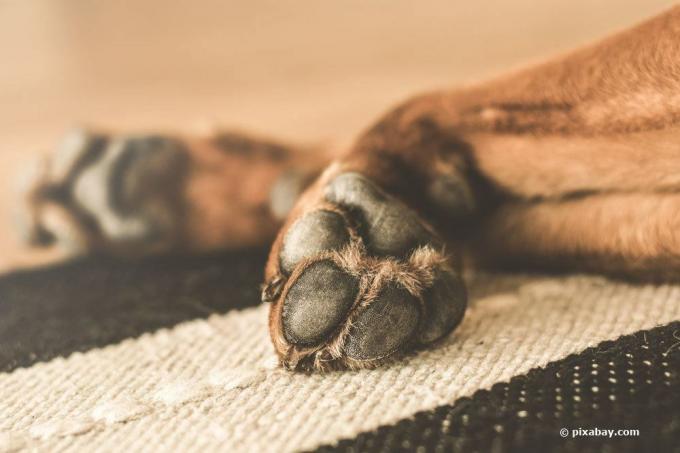
table of contents
- Wasp sting in dogs
- Symptoms & reactions
- relief
- Stitch in the mouth
- Stitch in the paw
- Prevent
A wasp sting usually causes only minor pain in the dog, combined with slight irritation in the skin. However, the sting in the sensitive mouth can be dangerous, while it is much more harmless in the paw. In some cases the animal will experience allergic reactions, especially if the wasp stings several times. In this case, the dog should definitely be seen by the vet.
Wasp sting in dogs
Dogs are naturally very curious and like to chase after all sorts of things that move. This natural hunting instinct does not stop at the insects, but some of them can defend themselves. This includes the wasps, which quickly feel provoked and then attack the attacker as a defense. The dog can also step on a wasp that is crawling around on the floor. In this case, it also stabs immediately to defend itself. Unlike bees, wasp stings have no barbs, so they usually don't get stuck in the skin.
- Wasp sting can be painful
- Through the stinger, the insect injects small amounts of poison into the skin
- Sensitive areas of the body, such as the mouth and throat, are more severely affected
- The paws also suffer from it
- A manageable wound forms
- Long-lasting pain is mainly caused by the poison
- Wasps can even sting several times
- The animal can experience allergic reactions
- In extreme cases, it is essential to visit the vet
Symptoms & reactions
If you have just one wasp sting, you usually do not expect serious symptoms. A harmless sting will only bother the dog for a short time; it usually heals on its own. However, if there has been a large number of stings, then caution is advised. The same is true if the pet is allergic to the wasp's poison. If the sting can still be seen in the wound, it must be removed promptly to prevent further inflammation. However, tweezers should not be used when pulling it out, as this will force the poison from the stinger deeper into the wound.
- Observe the dog for some time after the sting
- Signs of wasp stings are general weakness
- Difficulty breathing also often occurs
- In the case of allergies, large swelling forms around the affected area
- Pay particular attention to swelling of the head, mouth, neck and throat
- Swelling shouldn't last more than a few days
- Remove the stinger from the wound with a fingernail
- Alternatively, insert the corner of a thin cardboard
- In the event of severe reactions to the bite, go straight to the vet
relief
Most dogs are more frightened by the wasp sting than they are in great pain afterwards. However, in some cases there are increased reactions, especially if dirt has got into the wound and it becomes infected as a result. Wasps are particularly active during the warm months and often stay at ground level, especially when the nest is below the surface of the earth. Since a wasp sting often happens while walking, this wound cannot always be cleaned immediately. In order to alleviate further pain, natural home remedies are particularly useful when you come home.
- Mixing water and baking soda will reduce the pain
- Ice cubes also provide relief
- Wrap this in a tea towel and only then place it on the wound
- Running water also provides cooling
- Bathe the dog in the nearby stream or river
- This will reduce swelling and contain pain
- Poison consists of protein and is rendered ineffective by heat
- Use heat only on paws, not in the mouth
- Do not proceed too hot to avoid burns
- Test in the crook of your arm beforehand
Stitch in the mouth
If the wasp sting is in the area of the mouth, it can affect the affected dog dangerous will. If there is major swelling, this can lead to life-threatening shortness of breath in the animal. Allergic reactions and their symptoms usually appear shortly after the wasp sting and can vary widely in shape. Some of the shock symptoms even make the dogs unable to walk. In extreme cases, these fall over completely. As a rule, an allergy to wasps persists throughout the dog's life. In this case, repeated stitches require action more quickly. Veterinarians prescribe medication for emergencies, which must always be carried with you.
- Serious symptoms appear after seconds to minutes
- Persistent tremors and excessive panting are serious indicators
- Watch out for swelling airways
- Vomiting and diarrhea indicate allergic reactions
- Circulatory and respiratory problems can occur
- Consult a veterinarian immediately in the event of serious problems
- Medication with cortisone provides quick relief
Stitch in the paw
Compared to a wasp sting in the mouth, the sting in the paw is far less dangerous. However, this can change quickly ignitebecause the paw comes into contact with a lot of dirt. In combination with the poison from the wasp sting, the sting often leads to greater swelling, so that the affected dogs can no longer properly kick their paws.
- Carefully push the poison out of the puncture site
- Disinfect the paw immediately after the bite
- Ribwort helps as a disinfectant for walks
- Chew the leaves of the medicinal herb with plenty of spit
- Then put the pulp on the wound
- Reduce swelling by applying cold
Prevent
Certain factors should be taken into account so that the dog does not get a wasp sting in the first place. Especially in the warm summer months, the insects romp around in certain places that also magically attract pets. However, it is often possible to prevent the animal from being stung. Targeted training is also helpful so that the dogs do not want to hunt for insects or play with them.
- Pay attention to the increasing numbers of wasp colonies
- Do not leave dogs outside unattended
- Take care when feeding, both indoors and in the garden
- Wasps like to look for food bowls
- Be careful with windfalls under trees, remove them immediately



